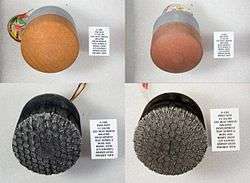AVCOAT

Apollo and Orion Avcoat
AVCOAT 5026-39 is a NASA code for a specific ablative heat shield material created by Avco[1][2] (acquired by Textron in 1984).[3] It is an epoxy novolac resin with special additives in a fiberglass honeycomb matrix. In fabrication, the empty honeycomb is bonded to the primary structure and the resin is gunned into each cell individually.[4]
History
AVCOAT was used for the heat shield on NASA's Apollo Command Module.[5] In its final form, this material was called AVCOAT 5026-39.
Although AVCOAT was not used for the Space Shuttle orbiters, NASA is using the material for its next generation Orion spacecraft.[6] The Avcoat to be used on Orion is reformulated to meet environmental legislation that has been passed since the end of Apollo.[7][8]
Specifications
- Material: epoxy novolac resin with special additives in a fiberglass honeycomb matrix.[4]
- Density: 32 pounds per cubic foot (0.51 g/cm3)[4]
- Post-ablation char-layer composition: 6.7 pounds per cubic foot (0.107 g/cm3) of carbon and 8 pounds per cubic foot (0.13 g/cm3) of silica.[4]
Flight use
Unmanned
Manned
- Apollo 7
- Apollo 8
- Apollo 9
- Apollo 10
- Apollo 11
- Apollo 12
- Apollo 13
- Apollo 14
- Apollo 15
- Apollo 16
- Apollo 17
- Skylab 2
- Skylab 3
- Skylab 4
- Apollo–Soyuz Test Project
- Early Space Shuttle flights[6]
References
- ↑ NASA's Exploration Systems Architecture Study - Chap.5 (Nov. 2005)
- ↑ Fire-Resistant Reinforcement Makes Steel Structures Sturdier (2006)
- ↑ Textron Systems History Archived November 30, 2010, at the Wayback Machine., 1984 History, "Textron acquires Avco, including Lycoming, to become Avco Systems Textron", 2010, accessed 2010-11-27.
- 1 2 3 4 5 Flight-Test Analysis Of Apollo Heat-Shield Material Using The Pacemaker Vehicle System NASA Technical Note D-4713, pp. 8, 1968-08, accessed 2010-12-26. "Avcoat 5026-39/HC-G is an epoxy novolac resin with special additives in a fiberglass honeycomb matrix. In fabrication, the empty honeycomb is bonded to the primary structure and the resin is gunned into each cell individually. ... The overall density of the material is 32 lb/ft3 (512 kg/m3). The char of the material is composed mainly of silica and carbon. It is necessary to know the amounts of each in the char because in the ablation analysis the silica is considered to be inert, but the carbon is considered to enter into exothermic reactions with oxygen. ... At 2160O R (12000 K), 54 percent by weight of the virgin material has volatilized and 46 percent has remained as char. ... In the virgin material, 25 percent by weight is silica, and since the silica is considered to be inert the char-layer composition becomes 6.7 lb/ft3 (107.4 kg/m3) of carbon and 8 lb/ft3 (128.1 kg/m3) of silica."
- 1 2 3 4 5 6 Apollo Experience Report - Thermal Protection Subsystem (Jan. 1974)
- 1 2 NASA.gov - NASA Selects Material for Orion Spacecraft Heat Shield (April 7, 2009)
- ↑ Flightglobal.com - NASA's Orion heat shield decision expected this month (Oct 3, 2009)
- ↑ Company Watch (Apr 12, 2009 )
External links
- Apollo Experience Report - Thermal Protection Subsystem (Jan. 1974)
- Apollo Seals: A Basis for the Crew Exploration Vehicle Seals (Nov. 2006)
- Notes on Earth Atmospheric Entry for Mars Sample Return Missions (Sept. 2006)
This article is issued from Wikipedia - version of the 11/14/2016. The text is available under the Creative Commons Attribution/Share Alike but additional terms may apply for the media files.